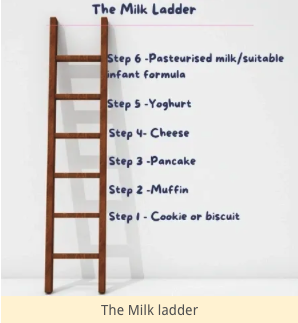Cow’s milk allergies and the milk ladder
Written by Emma Shafqat, Dietitian with a Difference
I have experience with cow’s milk allergies and dairy ladder (it is offically called the milk ladder) both professionally and personally. When my little girl was 12 months old, we made our first attempt at the milk ladder.
We made it past step one and two and then couldn’t get any further. Let’s just say there was a lot of crying and vomiting, so we took a break. After two more attempts and feeling like we would never enjoy birthday parties as a family, we finally made it to the top of the ladder when my daughter was three and a half… although - between you and me - she still flatly refuses cow’s milk, claiming she can’t have it, despite happily eating ice cream and chocolate milkshakes!
Suffice to say that I’ve been there. So here, I’ll take you through the types of cow’s milk allergies, signs and symptoms, and what to do if you think your child has a cow’s milk allergy.
What is a cow’s milk allergy?
Cow’s milk protein allergy (CMPA) is an abnormal response by the body’s immune system in which the proteins in cow’s milk are recognised as a potential threat. It is estimated to affect around 7% of babies under the age of one, although most children grow out of it by the age of five (NHS, 2019).
There are two main types of CMPA:
· IgE-mediated: typically rapid onset (within minutes and up to two hours after ingestion)
· Non-IgE-mediated: typically delayed onset (usually two to 72 hours after ingestion)
These two different types of allergies come with similar but slightly different signs and symptoms.
IgE-mediated signs and symptoms
· Itchy skin
· Rash or hives
· Swelling of the lips, face or around the eyes
· Atopic eczema
· Acute flare up
· Nausea
· Abdominal pain
· Vomiting
· Diarrhoea
· Coughing
· Chest tightness
· Wheezing or shortness of breath
· Sneezing
· Rhinorrhoea or congestion
Non-IgE-mediated signs and symptoms
· Itchy skin
· Rash or flushing
· Atopic eczema
· Vomiting or gastro-oesophageal reflux disease (GORD)
· Loose or frequent poos
· Constipation
· Blood and or mucus in poo
· Redness around the anus
· Abdominal pain or discomfort
· Colic
· Tiredness
· Food refusal or aversion
· Coughing
· Chest tightness
· Wheezing or shortness of breath
· Faltering growth with at least one or more gastrointestinal symptoms
This list of signs and symptoms is not complete and if your child has other symptoms that does not mean your child doesn’t have a food allergy. Please consult with your medical professional if you are concerned (1).
What to do if you think your child has CMPA?
If you think your baby is having a reaction to cow’s milk then you should go and see your GP to discuss your concerns. They will assess your baby’s symptoms to see if it could be a cow’s milk allergy. Make sure you get medical advice before taking cow’s milk out of your child’s diet.
What is the Milk Ladder (Dairy Ladder)?
The Milk Ladder is a technique of reintroducing your child to cow’s milk slowly so that their tolerance builds gradually. It is only suitable for children with milk to moderate non-IgE-mediated allergies, and you should always seek medical advice before attempting the Milk Ladder.
The Milk Ladder is a six step process, and I recommend referring to the official iMAP guide for details. It includes sweet and savoury recipes too.
But put simply, the Milk Ladder starts with more broken down forms of milk, like biscuits or pancakes, and builds up to things like yoghurt and cheese, until eventually your child can have fresh milk. This is because when milk is heated or baked, the protein changes so it is less allergenic.
Here is an overview of the steps, but please do refer to the official guidance and remember to always speak to your doctor about it first:
Step 1: Try a malted milk biscuit or cookie that contains milk as an ingredient. Start with just one and build up to three per day by day seven
Step 2: Try a muffin that contains milk (you can find recipes via the iMAP guide). Start with half and build up to a whole muffin.
Step 3: Try a pancake that contains milk. Start with half and build up to a whole pancake a day.
Step 4: Try 15g of hard cheese and build up to baked cheese, e.g. on pizza.
Step 5: Try to build up to 125g of yoghurt.
Step 6: Try pasteurised milk or suitable infant formula. Start with 100ml mixed with current formula and aim for 200ml.
If your child has a reaction at any of the steps please stop and contact your health professional before starting again.
Once you have reached the top of the ladder switch to cow’s milk in all food and cereals at breakfast.
If you are struggling with CMPA and would like more support you can visit my website - https://dietitianwithadifference.co.uk/ and book a customised cow’s milk reintroduction plan.
While you are here we have lots more blogs on various topics which you can find here, as well as our downloadable webinars on topics such as behaviour and emotions, sleep and toilet training.
Don’t forget that we offer parent consultations should you need support with anything from sleep to behaviour and so much more! Details of the packages we offer can be found here.
We also have a Podcast ‘Newborn to Teen and Everything in Between’, you can listen here.



